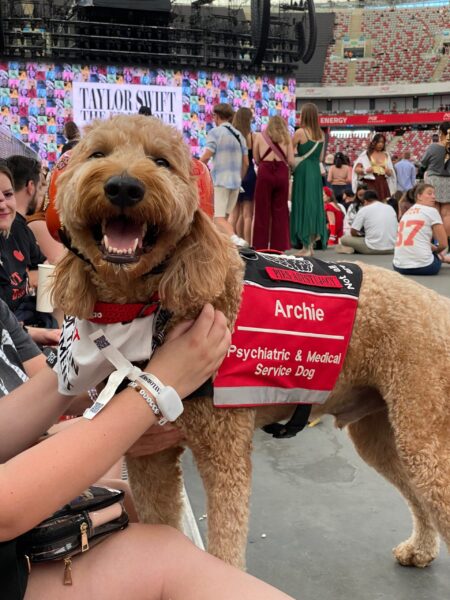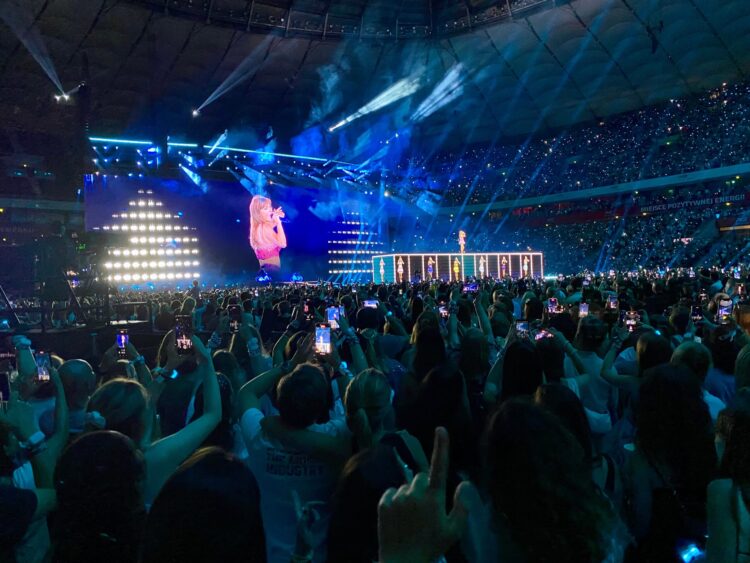EDITOR’S NOTE: Christian Lupsa attended a Taylor Swift concert Aug. 3, 2024, in Warsaw Poland. He wrote about the experience as part of his weekly “Draft Four” Substack essay. It is republished, lightly edited, with permission.
We’re entering late-summer melancholy, so I offer something sparky: 9 things Taylor Swift taught me about storytelling in a pop-listicle format.
Yes, the singer-superstar Taylor Swift. Call me a Swiftie, but know my case is a mild one. I saw her live in Warsaw, on her third consecutive night of playing in front of about 70.000 people. She performed for more than three hours, in a show I don’t think I can accurately describe because it was all about the feels. Let’s just say I cried about three or four times and I could barely move at the end. My Fitbit clocked almost 45.000 steps that day.
For me that was just one night, and Taylor has been on this tour since last year. That is dedication. Let’s get to those take-aways:
1. Structure.
Often the hardest job of storytelling is organizing the narrative in a coherent way. For “The Eras Tour,” Taylor drew on her 18 years of music as a frame and took us on a chronological journey: from teen-love days, to pick-your-adult-self-up moments, to modern midnights of existential questions. It works because good structure does this: It’s sufficiently predictable so you know where it’s going, and simultaneously mysterious enough to make you feel smart if you see something coming.
2. Setting.
What distinguishes memorable longform nonfiction from the rest of journalism is a story that takes place in a certain place, at a certain time. The characters work through their dilemmas and problems on a stage the author has to set right, because it influences the narrative. Taylor knows setting, especially on stage. Each “era” of her musical tour has its own colors, costumes, dances, props and visuals. You are not just listening to the songs live; you are moving through space and time.
3. Style.
If you are among the lucky ones, you’ll find your unique voice as a writer. I’m in the camp that believes Taylor is a pretty awesome lyricist; her bridges are the stuff of legend. She got where she is by doing this, over and over again. Find that thing that brings you pleasure when writing and do it – even overdo it – until you gain mastery over it.

4. Service.
A good story, in my kind of non-fiction at least, is in service of the reader. You are hired to lead a journey, sometimes with the destination unknown. On stage, Taylor is in service to her fans, who trade bracelets and dress up in era-specific outfits, and works extra hard to make it a special night for them. Much has been written about how strangely intimate she can make a show attended by tens of thousands of people. And she does. She is there for you, and you don’t doubt it for one minute. There were even therapy dogs on site to quell anxiety. Be there for your readers, too.
5. Surprise.
A good structure should leave room for surprise. One of Roy Peter Clark’s pieces of wisdom I go back to is about letting your readers stumble upon gold coins, meaning unexpected information or moments in your piece. Taylor does this in many ways: Her dive into a hole in the stage was neat. But a simpler and more effective surprise involves her performing an acoustic version of two different songs at each concert, one on guitar, one on piano. Someone who saw Swift in another venue told me he wished he caught a concert where she sang “Exile.“ She did that in Warsaw, on piano.
6. Symbolism.
In a story, there are always some elements that can stand in for the larger idea you want to put across. On stage, colors and props do that nicely. So does a visual of a snake to convey the idea of a slippery and dangerous character – that’s from Taylor’s “Reputation” era. They also set an internal rhythm and allow a narrative shift from action to reflection.
7. Simplicity.
A young journalist once said that her desire was to write simply about complicated things. But simple is not simplistic and, in my experience, those that meander and have a muddied prose didn’t do enough reporting and don’t have clarity of purpose. It’s usually not the overload of knowledge that prevents them from being simple; it’s the lack of it. Pop is also simple, but mastering the 3-4 minute song requires time, patience and a lot of exercise.
8. Sparkle.
When the confetti dropped at the end of the show, and everyone’s bracelets started flashing, and the performers were taking their bows, everything seemed possible for a moment, and the world was all right. I left the concert grateful for the experience — and wishing we thought of journalism more often as making people feel like they’ve been through an unforgettable experience. The daily problems will be there when you wake up; can I make you forget about them for a little while?
9. Share.
Taylor shared the stage with Paramore, a band I’ve loved for 20 years. She recently announced different extra opening acts for every show in London. There’s a spirit of generosity that carries through, and people reciprocate. You don’t make your own dress for any artist, after all. She has made life in prison easier for some. My friend Laura Trujillo, who works for USA Today, shared this beautiful, intimate story of going to Milan to see Taylor with her 18-year-old daughter, Lucy. Taylor Swift isn’t just the world’s biggest pop star: she is also something mothers and daughters share. In Vienna, after Taylor’s shows this week were cancelled because of a terrorist warning, people gathered in the streets, played her songs, and swapped bracelets. “I’m officially a Swiftie,” a friend who was there texted me. “It’s the most wholesome thing in the world.”
Can our journalism aim to be more like this?




